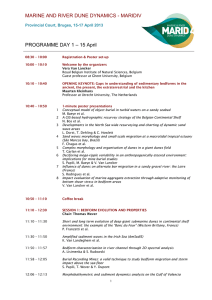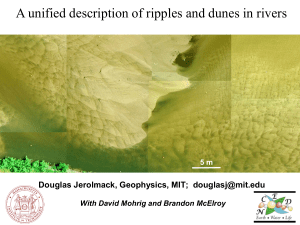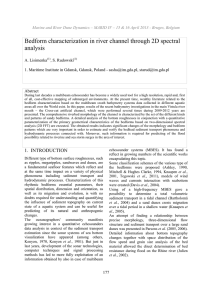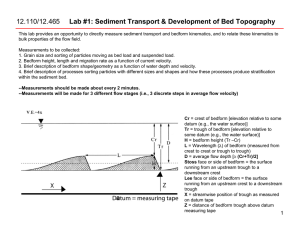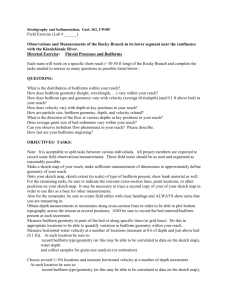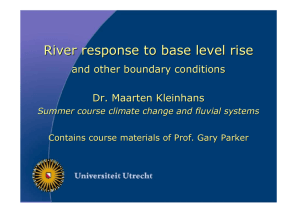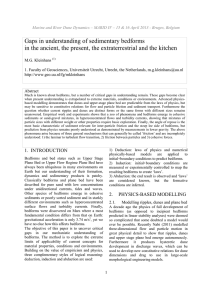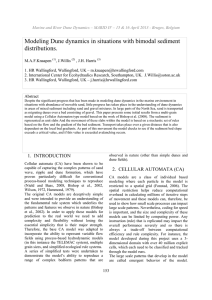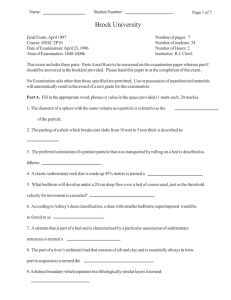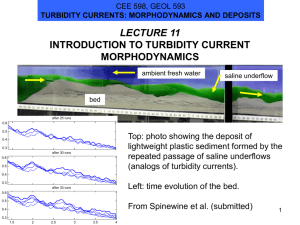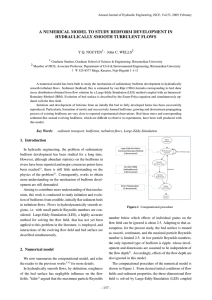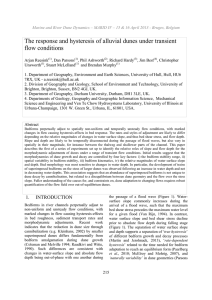CAS - Edibon
advertisement
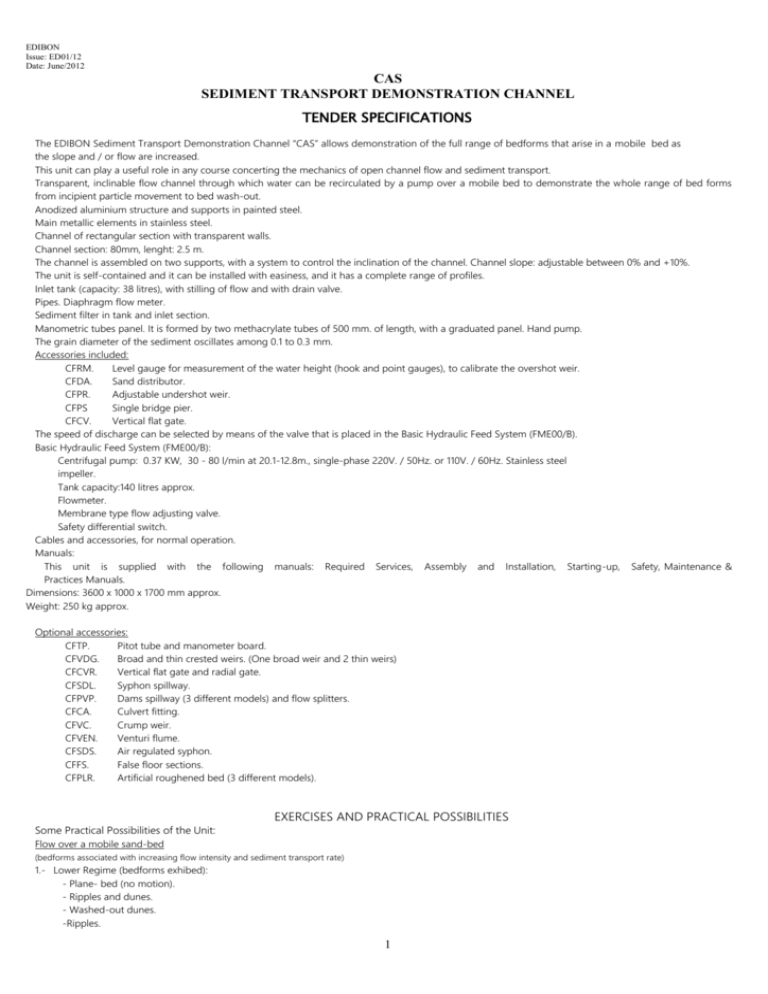
EDIBON Issue: ED01/12 Date: June/2012 CAS SEDIMENT TRANSPORT DEMONSTRATION CHANNEL TENDER SPECIFICATIONS The EDIBON Sediment Transport Demonstration Channel “CAS” allows demonstration of the full range of bedforms that arise in a mobile bed as the slope and / or flow are increased. This unit can play a useful role in any course concerting the mechanics of open channel flow and sediment transport. Transparent, inclinable flow channel through which water can be recirculated by a pump over a mobile bed to demonstrate the whole range of bed forms from incipient particle movement to bed wash-out. Anodized aluminium structure and supports in painted steel. Main metallic elements in stainless steel. Channel of rectangular section with transparent walls. Channel section: 80mm, lenght: 2.5 m. The channel is assembled on two supports, with a system to control the inclination of the channel. Channel slope: adjustable between 0% and +10%. The unit is self-contained and it can be installed with easiness, and it has a complete range of profiles. Inlet tank (capacity: 38 litres), with stilling of flow and with drain valve. Pipes. Diaphragm flow meter. Sediment filter in tank and inlet section. Manometric tubes panel. It is formed by two methacrylate tubes of 500 mm. of length, with a graduated panel. Hand pump. The grain diameter of the sediment oscillates among 0.1 to 0.3 mm. Accessories included: CFRM. Level gauge for measurement of the water height (hook and point gauges), to calibrate the overshot weir. CFDA. Sand distributor. CFPR. Adjustable undershot weir. CFPS Single bridge pier. CFCV. Vertical flat gate. The speed of discharge can be selected by means of the valve that is placed in the Basic Hydraulic Feed System (FME00/B). Basic Hydraulic Feed System (FME00/B): Centrifugal pump: 0.37 KW, 30 - 80 l/min at 20.1-12.8m., single-phase 220V. / 50Hz. or 110V. / 60Hz. Stainless steel impeller. Tank capacity:140 litres approx. Flowmeter. Membrane type flow adjusting valve. Safety differential switch. Cables and accessories, for normal operation. Manuals: This unit is supplied with the following manuals: Required Services, Assembly and Installation, Starting-up, Safety, Maintenance & Practices Manuals. Dimensions: 3600 x 1000 x 1700 mm approx. Weight: 250 kg approx. Optional accessories: CFTP. Pitot tube and manometer board. CFVDG. Broad and thin crested weirs. (One broad weir and 2 thin weirs) CFCVR. Vertical flat gate and radial gate. CFSDL. Syphon spillway. CFPVP. Dams spillway (3 different models) and flow splitters. CFCA. Culvert fitting. CFVC. Crump weir. CFVEN. Venturi flume. CFSDS. Air regulated syphon. CFFS. False floor sections. CFPLR. Artificial roughened bed (3 different models). Some Practical Possibilities of the Unit: EXERCISES AND PRACTICAL POSSIBILITIES Flow over a mobile sand-bed (bedforms associated with increasing flow intensity and sediment transport rate) 1.- Lower Regime (bedforms exhibed): - Plane- bed (no motion). - Ripples and dunes. - Washed-out dunes. -Ripples. 1 EDIBON Issue: ED01/12 Date: June/2012 CAS SEDIMENT TRANSPORT DEMONSTRATION CHANNEL -Dunes. 2.- Upper Regime(bedforms exhibed): - Plane- bed (with motion). - Chutes and pools. - Anti- dunes. - Breaking anti-dunes. - Standing waves. Flow over fixed, gravel-bed 3.- Although the channel can not transport gravel, this can be used to investigate flow resistance in gravel and polder- bed rivers. 4.- We can calculate the flow resistance coeficients, using equations such as those of Bray, Limerinos, Hey, Lacey, Thompson and Campbell and Bathurst and the results compared to the actual values obtained by observation. Flow structures 5.- We can examine the structure of turbulence in the flow, using dye injection, interesting for the dune bedform configuration and clearly demonstrates separation on the lee face. Fixed, smooth bed flow (the channel may be used without sediment on the bed to demonstrate several flow phenomena and equations) 6.- Rapid, super- critical flow- dominance of intertial over gravity forces, shock waves from flow obstructions. 7.- Turbulence. 8.- Governing equations of open channel flow-Reynold’s number, Froude number, continuity, Bernoulli’s equation, weir equations. 9.- Tranquil, sub-critical flow- movement of surface waves upstream against flow. 10.-Hydraulic jump- transition from super to sub critical flow, air entrainment, mixing. 11.-Flow measurement- using sharp crested weirs. Bedform hysteresis 12.-If the discharge in the channel changes quickly, there is no sufficient time for bedforms to adjust to the new flow regime. Hence, if a flood hydrograph is simulated by increasing and then decreasing the discharge, different depths will occur for the same discharge on the rising and falling limbs. Data collection and numerical evaluation(computational work) 13.-In addition to illustrating flow and sediment phenomena, we can use the channel for basic data collection and numerical evaluation of the following: - Flow resistance: Manning, Chezy and Darcy-Weisbach fricion factors for several bedform configuration. - Bedform prediction: Velocity-Hjulstrom diagram. Suspended load-movement by suspension. Shields parameter-Bogardi diagram. Stream power-Simons and Richarson charts. Boundary shear stress-Leeder chart. - Initiation of motion: Shields diagram. Hjulstrom’s curve. Mechanics of sediment transport 14.-We can observe the movement of grains, starting from a plane- bed with no motion, on the following: - Initiation of motion. - Trajectory of initial motion. - Movement by rolling and sliding (contact load). - Movement by hopping (saltation load). - Movement by suspension. Depositionary features and facies 15.-We can observe the deposition of sediment load and the resulting patterns of grains within the sand body may be identified. Local scour 16.-Scour under boils and vortices in the flow is observed under both the lower and upper regime bedforms. Obstructions may be introduced to represent bridge piers, sills, revetments, etc, and the resulting pattern of scour examined. Other possible practices: 17.-Behaviour study of the connection to the drain of a channel with sendiment. 18.-Turbulence study by means coloration. 19.-Calculation of water flow. 2
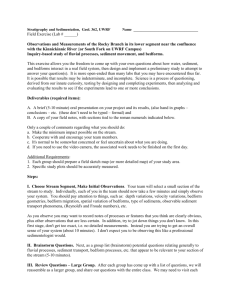
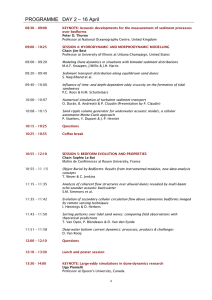
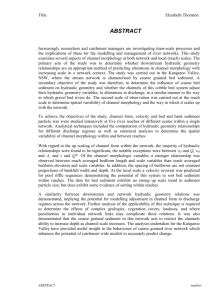
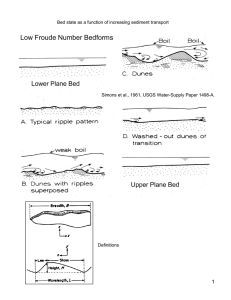



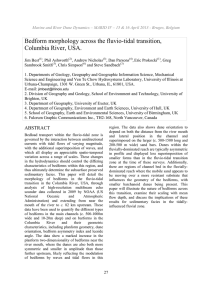

![科目名 Course Title Hydrology and Hydraulics [水文・水理学E] 講義](http://s3.studylib.net/store/data/007224993_1-7df83ced7f13c8565ece0b752f37d756-300x300.png)
